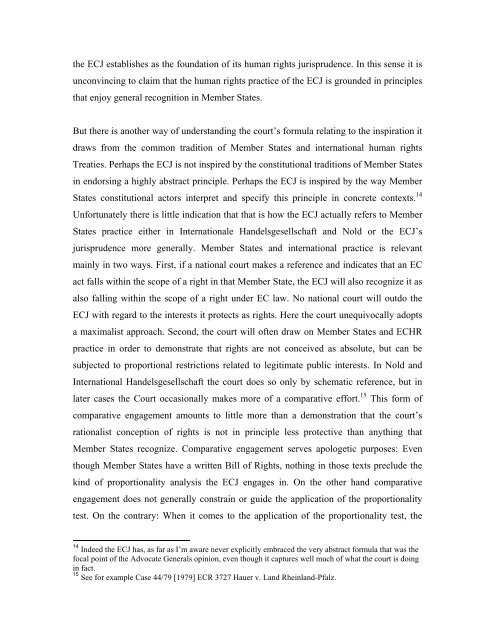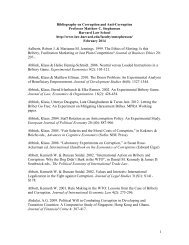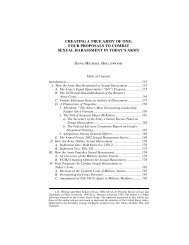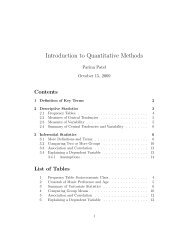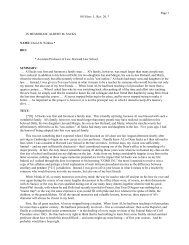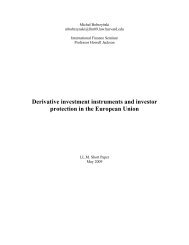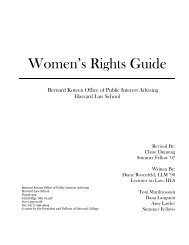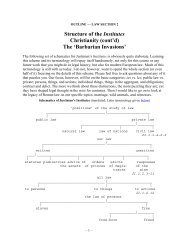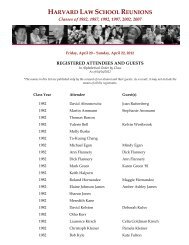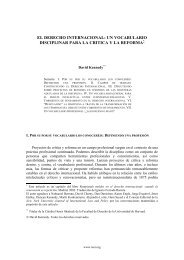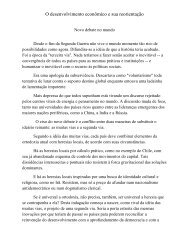Internationale Handelsgesellschaft, Nold and the New Human ...
Internationale Handelsgesellschaft, Nold and the New Human ...
Internationale Handelsgesellschaft, Nold and the New Human ...
You also want an ePaper? Increase the reach of your titles
YUMPU automatically turns print PDFs into web optimized ePapers that Google loves.
<strong>the</strong> ECJ establishes as <strong>the</strong> foundation of its human rights jurisprudence. In this sense it is<br />
unconvincing to claim that <strong>the</strong> human rights practice of <strong>the</strong> ECJ is grounded in principles<br />
that enjoy general recognition in Member States.<br />
But <strong>the</strong>re is ano<strong>the</strong>r way of underst<strong>and</strong>ing <strong>the</strong> court’s formula relating to <strong>the</strong> inspiration it<br />
draws from <strong>the</strong> common tradition of Member States <strong>and</strong> international human rights<br />
Treaties. Perhaps <strong>the</strong> ECJ is not inspired by <strong>the</strong> constitutional traditions of Member States<br />
in endorsing a highly abstract principle. Perhaps <strong>the</strong> ECJ is inspired by <strong>the</strong> way Member<br />
States constitutional actors interpret <strong>and</strong> specify this principle in concrete contexts. 14<br />
Unfortunately <strong>the</strong>re is little indication that that is how <strong>the</strong> ECJ actually refers to Member<br />
States practice ei<strong>the</strong>r in <strong>Internationale</strong> <strong>H<strong>and</strong>elsgesellschaft</strong> <strong>and</strong> <strong>Nold</strong> or <strong>the</strong> ECJ’s<br />
jurisprudence more generally. Member States <strong>and</strong> international practice is relevant<br />
mainly in two ways. First, if a national court makes a reference <strong>and</strong> indicates that an EC<br />
act falls within <strong>the</strong> scope of a right in that Member State, <strong>the</strong> ECJ will also recognize it as<br />
also falling within <strong>the</strong> scope of a right under EC law. No national court will outdo <strong>the</strong><br />
ECJ with regard to <strong>the</strong> interests it protects as rights. Here <strong>the</strong> court unequivocally adopts<br />
a maximalist approach. Second, <strong>the</strong> court will often draw on Member States <strong>and</strong> ECHR<br />
practice in order to demonstrate that rights are not conceived as absolute, but can be<br />
subjected to proportional restrictions related to legitimate public interests. In <strong>Nold</strong> <strong>and</strong><br />
International <strong>H<strong>and</strong>elsgesellschaft</strong> <strong>the</strong> court does so only by schematic reference, but in<br />
later cases <strong>the</strong> Court occasionally makes more of a comparative effort. 15 This form of<br />
comparative engagement amounts to little more than a demonstration that <strong>the</strong> court’s<br />
rationalist conception of rights is not in principle less protective than anything that<br />
Member States recognize. Comparative engagement serves apologetic purposes: Even<br />
though Member States have a written Bill of Rights, nothing in those texts preclude <strong>the</strong><br />
kind of proportionality analysis <strong>the</strong> ECJ engages in. On <strong>the</strong> o<strong>the</strong>r h<strong>and</strong> comparative<br />
engagement does not generally constrain or guide <strong>the</strong> application of <strong>the</strong> proportionality<br />
test. On <strong>the</strong> contrary: When it comes to <strong>the</strong> application of <strong>the</strong> proportionality test, <strong>the</strong><br />
14 Indeed <strong>the</strong> ECJ has, as far as I’m aware never explicitly embraced <strong>the</strong> very abstract formula that was <strong>the</strong><br />
focal point of <strong>the</strong> Advocate Generals opinion, even though it captures well much of what <strong>the</strong> court is doing<br />
in fact.<br />
15 See for example Case 44/79 [1979] ECR 3727 Hauer v. L<strong>and</strong> Rheinl<strong>and</strong>-Pfalz.


